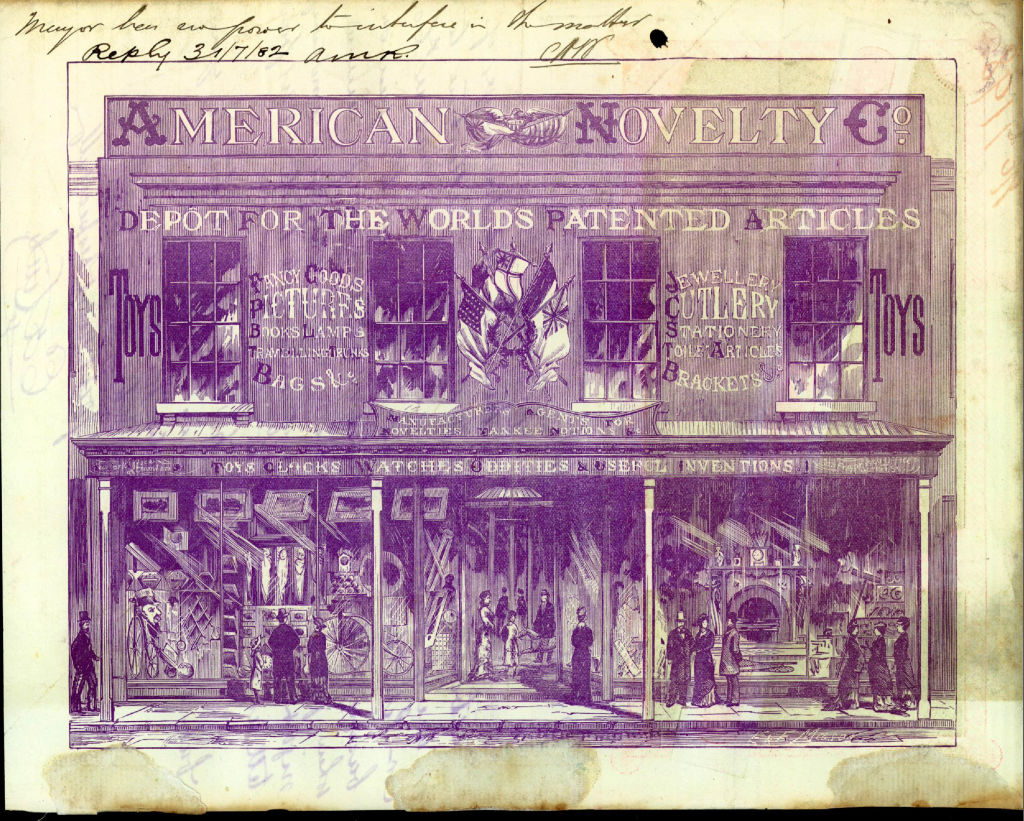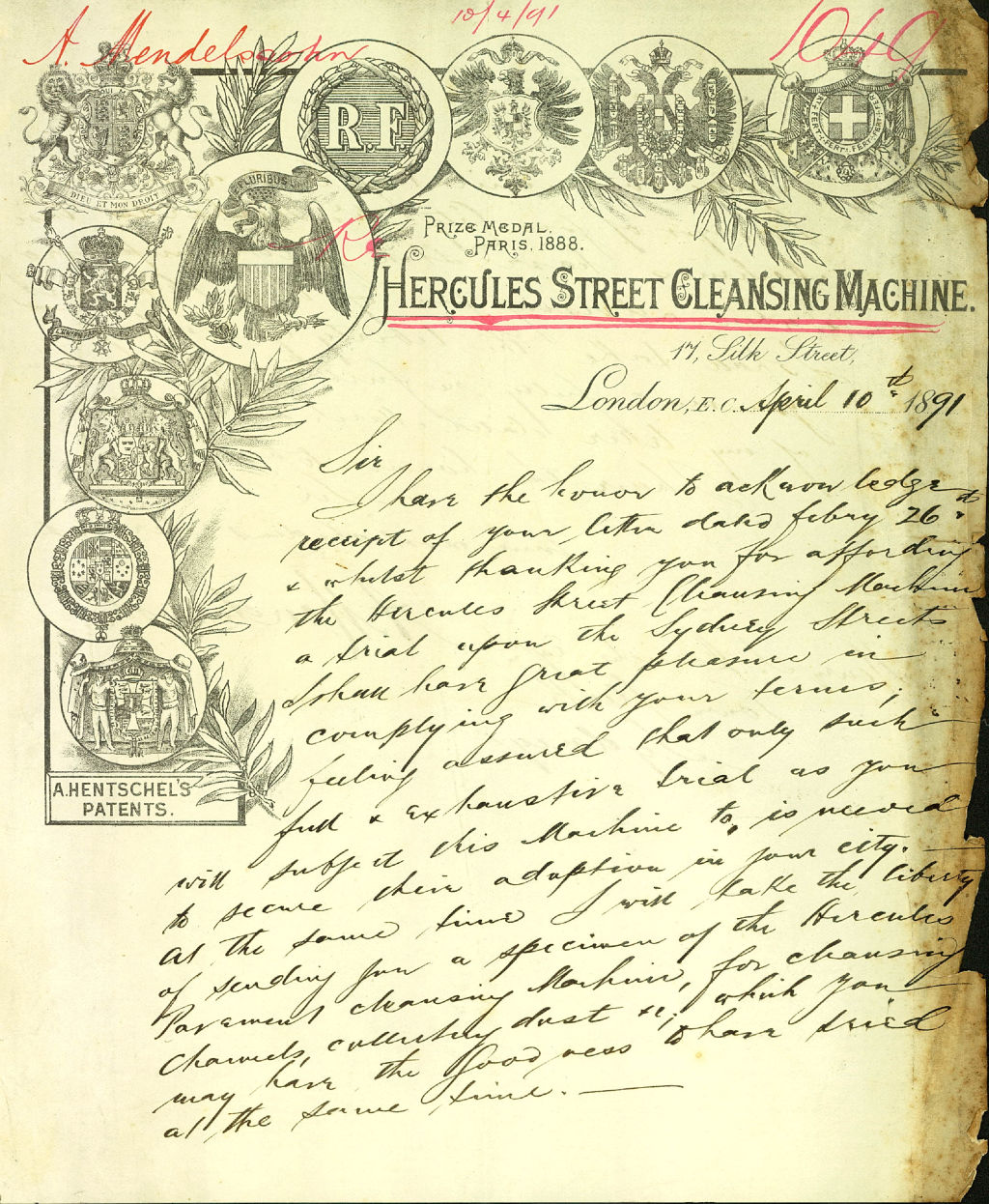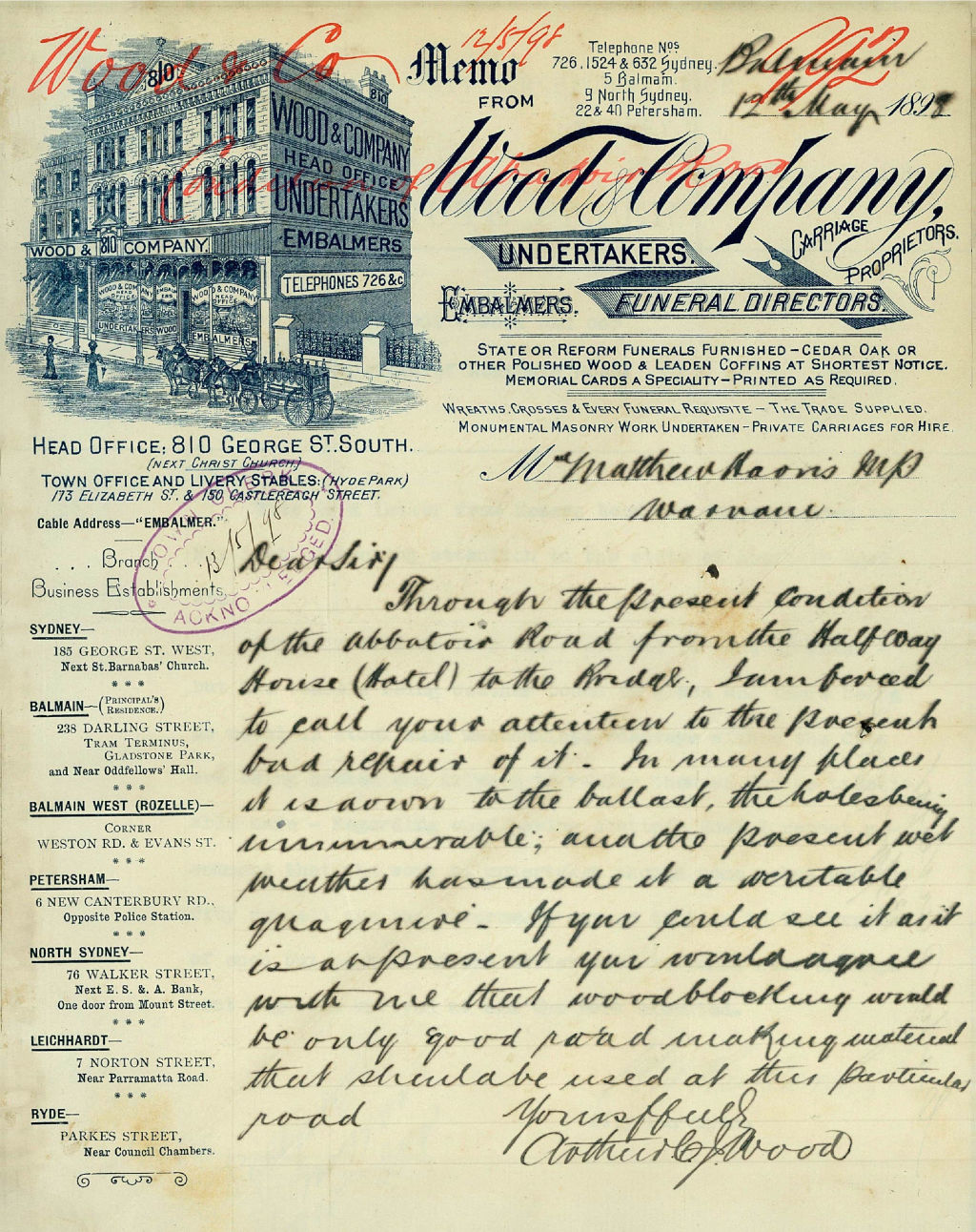Discover more letters and historic material from Sydney in the Archives & History Resources catalogue.
Published 1 September 2022
Explore the stories and beauty of decorative 19th and early 20th century requests, demands and complaints.
Interrupting mid-over? It’s just not cricket. In this letter, ironmongers Holdsworth, Gardyne & Co draw the attention of the City of Sydney to an overbearing ranger. The ranger allegedly disrupted a ‘quiet’ Saturday game of cricket against Farmer & Co in Moore Park. He demanded to see proof that they were allowed to play there.

Based on the image in their letter, we’re not sure what the American Novelty Company didn’t sell. But we do know it wasn’t happy about unauthorised trade. The manager, Mr EA Little, writes about a man trading every night on a vacant lot nearby, injuring their trade.
We wonder if he was selling the same mix of fancy goods and inventions listed on the store front.
In a very un-merry turn of events, fire destroyed the Pitt Street building on Christmas Eve in 1884.

There’s clean, and then there’s Hercules Pavement Cleansing Machine clean. Mr A Mendelssohn writes to the town clerk that he has taken the liberty of sending a Hercules Pavement Cleansing Machine along with the Street Cleaning Machine to be trialled for use in the city.
Finance Committee reports from 1891 to 1899 document the decision to acquire the machines for trial and include a pamphlet with descriptions, photographs and testimonials.

Spruikers have been on our streets for over 100 years.
In 1893, Allan Hamilton of Fillis’ Circus asks permission for 20 or 30 ‘sandwich’ men to parade the city streets advertising the opening of Fillis’ Great Circus and Menagerie at the old Exhibition Building in Prince Alfred Park.
He advises that the ads would be worn “over their shoulders in the usual manner”. Mr Hamilton assures the advertisements would be “free from the slightest objectionable matter”.

Captain Thomas Tuck, commander of the Paddington Brewery Volunteer Fire Brigade (we assume they put out fires with water, not beer), asks whether it may have the large alarm bell from the old George Street Markets, today’s Queen Victoria Building, which is about to be demolished.
A note attached to the letter says the Church of England people were hoping to use the same bell and the request is marked “Council will reprise the bell themselves”. The engine pictured on the letterhead is the Greenwich, one of Merryweather & Son’s steam fire engines.

Anthony Hordern & Sons complains that closing the public urinal at the corner of Hay Street and Park Lane at 10pm results in people using nearby doorways, which is a threat to public health. The City of Sydney agrees to keep the lavatory open until midnight.
The building featured on the letterhead is Anthony Hordern & Sons’ Palace Emporium, Haymarket built in 1879. The building was famously gutted by fire in 1901 then rebuilt and re-opened in 1906. The New Palace Emporium, Brickfield Hill stretched across half a city block and had 3 street frontages on George, Pitt and Goulburn streets.

Washington H Soul & Co complains about 2 summonses received from Town Hall, one to remove signs over the footway and a second issued to its assistant for sweeping the pavement.
The letterhead shows the company’s 2 buildings in Pitt Street, windows advertising patent medicines, druggists, sundries, perfume depot, brushes, combs, sponges and other toilet requisites.
We now know the pharmacy store Washington H Soul & Co as Soul Pattinson and the building on the left-hand side of the letterhead still stands today in the Pitt Street Mall.

Sanitation used to be a much more complicated process in our city. In this letter, C Morrison complains that his house refuse has not been removed, stating that small yards in his part of the city means it is “a positive menace to the health of my family”. His store was on Oxford Street in the block that now includes the Burdekin Hotel.
The letterhead describes Mr Morrison as an interior decorator, painter, signwriter and importer of paper hangings, glass, oils and colours. He is listed in the 1898 SANDS Postal Directory as an oil and colourman.

Arthur Wood of Wood & Company, undertakers, embalmers, funeral directors and carriage proprietors, complains about the poor condition of Abbatoir Road, “the holes being immeasurable” and the wet weather having made it “a veritable quagmire”.
The City of Sydney agrees repairs are necessary. This letterhead functions like an advertisement, promoting “coffins at shortest notice”, printed memorial cards and even monumental masonry work. The building pictured was the company’s main building at 810 George Street, next to Christ Church St Laurence.

Mr G Reeve of Union Piano & Organ Tuning Company tenders for the lease of number 3 shop in the Victoria Markets, today’s Queen Victoria Building. He seeks a 5-year lease at £40 per year “on condition that no poultry, bird, butcher, bacon business be allowed next door”. Letterheads can also give information about other businesses of the time. On this letterhead, the name of printing firm W Ackhurst & Co is inscribed below the piano.

The manager of the Scottish Metropolitan Life Assurance Company sends receipts for the insurance of lifts in the Victoria Markets Building. At the 1051st meeting of Council, on 13 September 1899, the City Solicitor and Lord Mayor approved the decision to insure the 3 passenger lifts in the Queen Victoria Market Buildings against accident.

Frank Grimley, ironmonger, coachbuilder, saddler, importer of bicycles, bicycle materials and sundries, requests repairs to the roadway in Druitt Street, where the metal is washed away to such an extent that he can’t back his cart into his yard. Grimley complained about Clarence Street too, stating, “I thought I knew Clarence Street pretty well, but I made a closer acquaintance with it than I desired owing to the defects.”

This is the second of 2 letters from the Computing Scale Co, regarding the cancellation of its lease on office number 9 on the second floor of the market buildings, today’s Queen Victoria Building. The company requested to have the lease terminated due to a depression in business and offered to leave the office fittings to the City of Sydney. The lease was cancelled on the terms offered.

George, Wells and Matthews, auctioneers and commission agents for HC Matthews Acme Roller Mills in Bathurst, asks to relocate the water services to its new offices in the Corporation Buildings at 173 Sussex Street. The letterhead design shows the range of grains and produce on offer: flour, bran, pollard, maize whole or cracked, oats, hay, chaff, chick wheat as well as sacks, screenings and cornsacks.

Batson & Co writes to Lord Mayor Matthew Harris to complain about the tendering process for printing and binding of books required by the City of Sydney.
Letterheads can give researchers many useful alternate terms for searching.
For instance, if you were searching for 19th century printers, you might try lithographers, stationers, engravers, stereotypers, artists or process engravers.

Fitz-Gerald Bros Circus is one of 2 circuses to tender for use of City parks to present their shows over Easter. It requested and was granted the use of Belmore Park for the Easter season while Wirth Bros circus allocated a portion of Prince Alfred Park for the same purpose.

Discover more letters and historic material from Sydney in the Archives & History Resources catalogue.
Published 1 September 2022